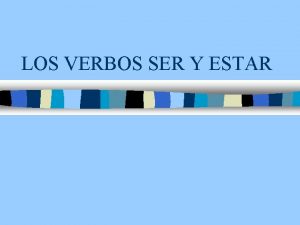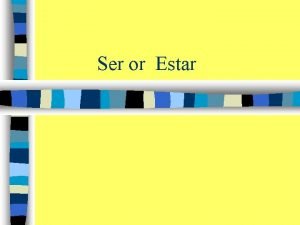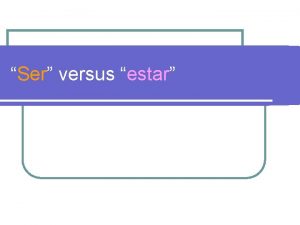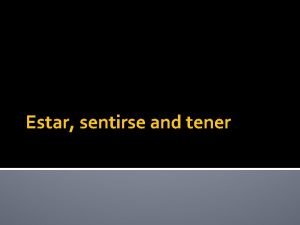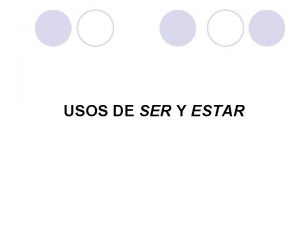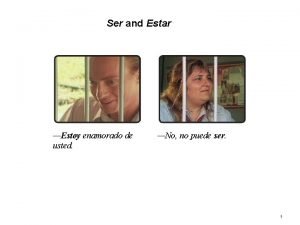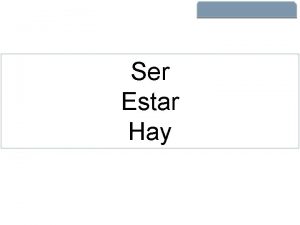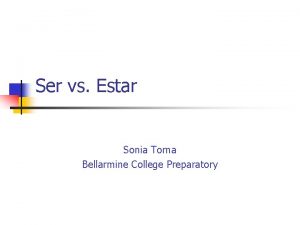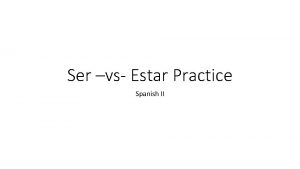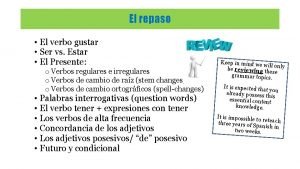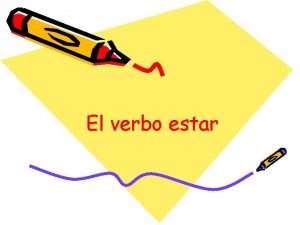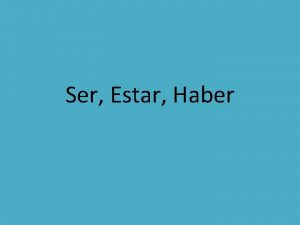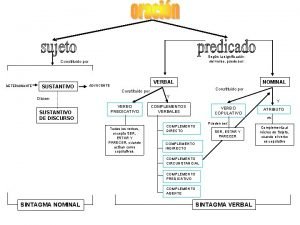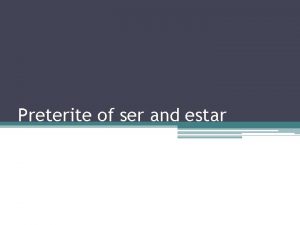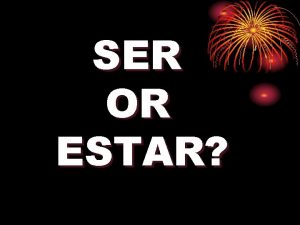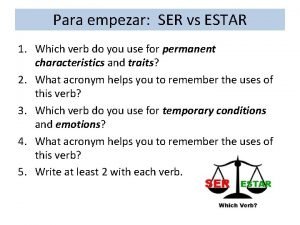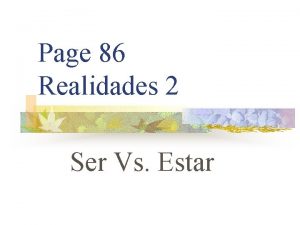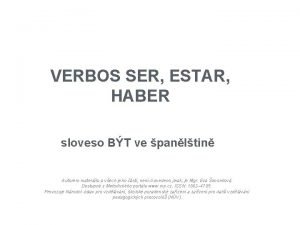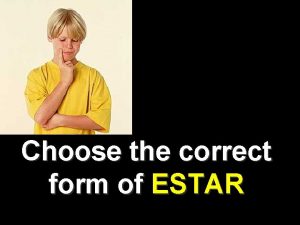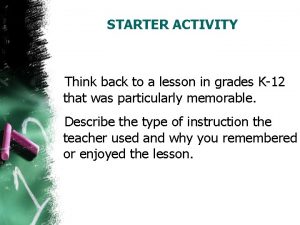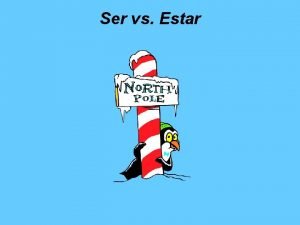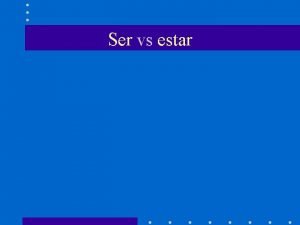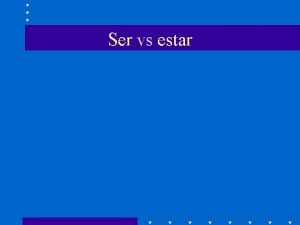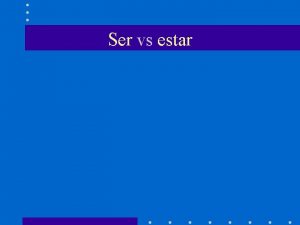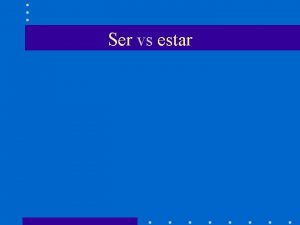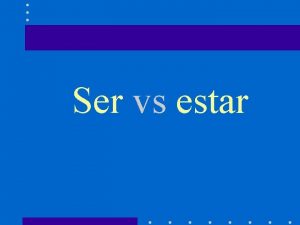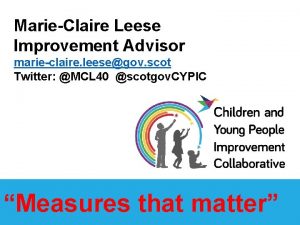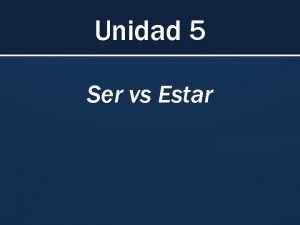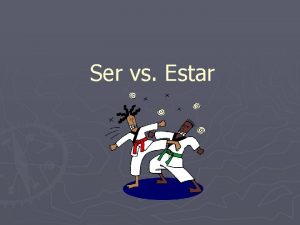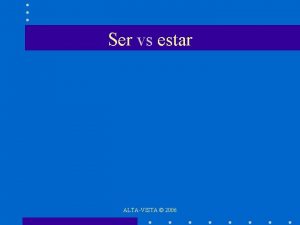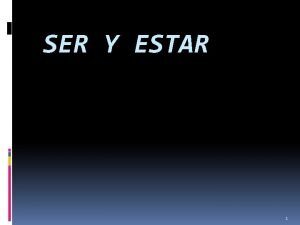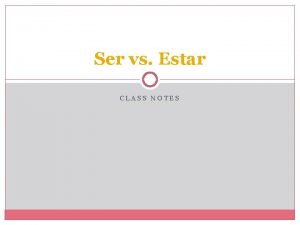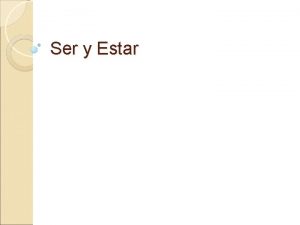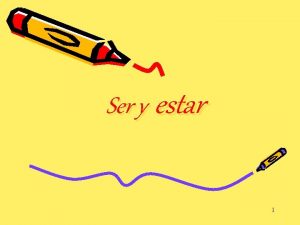Ser vs Estar MarieClaire Hunter 2013 www learnenglishspanishonline









































- Slides: 41

Ser vs Estar © Marie-Claire Hunter, 2013 www. learnenglishspanishonline. com

Did you know that in Spanish there are two ways to say ‘I am’? SOY = I AM (from the verb ser) & ESTOY = I AM (from the verb estar)

SOY = I AM Soy alto. I am tall.

Soy = I am Soy alta. I am tall.

Estoy = I am Estoy contento. I am happy.

Estoy = I am Estoy contenta. I am happy.

Words with gender! Did you notice that the tall man said ‘soy alt. O’ but the tall lady said ‘soy alt. A’? Also, the boy sheep said ‘estoy content. O’ but the girl sheep said ‘estoy content. A’.

Did you notice any pattern with those adjectives? (alto, alta, contento, contenta etc. ) Well if a describing word (ie. an adjective) ends in ‘o’ it will be used to describe a masculine noun. But if a describing word ends in ‘a’ it is used to describe a feminine noun.

And if an adjective describes more than one noun you make it plural by adding an ‘s’ Estoy contenta. Estamos contentas.

So, that covers most adjectives that end in ‘a’ or ‘o’. But as you know, sometimes it’s nice to share! So, if the describing word ends in a letter other than ‘o’ or ‘a’ then masculine and feminine nouns can usually share it.

Estoy = I am Estoy triste. I am sad.

Estoy = I am Estoy triste también. I am sad too.

Why 2 ways to say ‘I am’? I bet you’re wondering, why are there two ways to say ‘I am’ – what’s the difference?

Ser & Estar ‘Soy comes from the verb ‘ser’ and ‘estoy’ comes from the verb ‘estar’. Both of these Spanish verbs are the equivalent of the English verb ‘to be’. The difference is that these two verbs present the action or state of ‘being’ from different perspectives. Let’s see what they are.

In a nutshell A general rule might be … Use ‘soy’ (and any other form of the verb ser) to speak of characteristics, to identify or to define. And use ‘estoy’ (and any other form of the verb estar) to speak about states, emotions, actions or locations, . (Bearing in mind that in grammar, rules are rarely if ever absolute and you will likely come across some exceptions!)

For those of you who like acronyms one memory aid might be … That the three letter verb SER goes with C. I. D. Characteristics, Identity & Definitions And E-STAR – with the S. E. A. L. as the ‘star’ of the show States, Emotions, Actions & Locations.

So let’s expand on those thoughts … ‘Ser’ for characteristics Use the verb ‘ser’ to describe ‘what you are’ or ‘what you are like’ as a person. ‘Soy’ is from the verb ‘ser’ and means ‘I am’.

What are you? Soy humano. I’m human. Soy humana. I’m human.

What are you like? Soy amable. I’m kind.

Define your personality. Remember to make the first and second adjectives feminine by changing the last ‘o’ to an ‘a’ if you’re a girl. Ie. ‘adventurera’ and ‘tímida’. I’m adventurous. I’m timid. I’m friendly. Soy adventurero. Soy tímido. Soy amigable.

Your job & your religion In Spanish being a student, having a profession or belonging to a religion are considered to be things that make you ‘who you are’ so use ‘soy’ to say ‘I am a student’, or to state your profession or religion.

Tip for the day! Drop the ‘a’. Just a note to remember, when it comes to your profession or your religion in Spanish, you don’t need to translate the ‘a’. I’m (a) doctor = Soy médico.

Soy = I am Soy estudiante. I’m a student.

Soy = I am Soy estudiante también. I’m a student too.

And now some examples with ‘estar’ Estar for locations … a) for locations of people or things (other than events, for those use ser) ‘Estoy’ (I am) is from the verb ‘estar’. Estoy en Nueva Zelanda. I’m in New Zealand.

Estar for emotions … b) to describe ‘how’ someone is feeling. ¡Estoy enojada! I am annoyed!

Estar for states … c) to describe a state that someone or something is in Estoy ocupado. I’m busy.

Estar for actions … d) to describe an action that is taking place Estoy escribiendo. I’m writing.

So know you know all about the two Spanish ways to say ‘I am’

But it can’t all be about you! So far we’ve only learnt how to say ‘I am’ but I’m sure you’d like to talk about other people besides yourself. To do that we need to know how to manipulate ‘ser’ and ‘estar’ to fit other people. This is called ‘conjugating a verb.

Let’s get conjugating! As you probably know, verbs are all about expressing actions or states. Ser and estar are called verb infinitives. These verb infinitives express the action or state of ‘being’ but they don’t tell us who is doing the action of the verb or when the action is happening. Conjugating a verb means manipulating it to reflect who is doing the action or who is in the state and when it is happening.

Let’s start by conjugating the verb ‘to be’ in English In your mother tongue, or the language that you learnt as a child, you probably conjugate verbs as you go without even knowing that you are doing it. You usually do it one person at a time to fit in the sentence that you are saying or writing but let’s conjugate the verb ‘to be’ for all the possible people that there are. Firstly, we need to decide which ‘tense’ or ‘time’ we want to talk about (eg. present, past or future) – for this example we’ll use the present tense, then we take all the possible people who could do the action and we manipulate or ‘conjugate’ the verb to match the people. Verb infinitive = to be I am you are he is, she is we are they are NB: Those words we use for the people are called ‘personal pronouns’.

Now let’s try with ‘ser’ and ‘estar’ ‘Soy’ (I am) and ‘estoy’ (I am) are the first two conjugations of these very important verbs … and now let’s see how to conjugate those two verbs for all the other people who may want to ‘be’ something.

First let’s learn the Spanish personal pronouns. yo = I tú = you (informal ‘you’ for friends or young people) él = he ella = she usted = you (formal ‘you’ for older people etc) nosotros (mixed group or all males) or nosotras (all females) = we *vosotros = you, you all (the ‘informal’ plural ‘you’ for more than one person) ustedes = you, you all (the ‘formal’ plural ‘you’ for more than one person) ellos (mixed group or all males) or ellas (all females) = they * NB: you will notice that Spanish has four different ways to say ‘you’. ‘Tú’ which is the ‘informal singular you’ that you use for friends, peers or people younger than you, ‘usted’ which is the ‘formal singular you’ that you use for older people or to show respect, ‘ustedes’ which is technically the formal plural you’ but in Latin America it is the only plural you that is used, and finally you have ‘vosotros’, the informal plural you used which is only in Spain. NB: Some Latin American countries also use ‘vos’ but that’s a whole ‘nother story

And now the present tense conjugations for ‘ser’ and ‘estar’ for everyone! Personal Pronouns Ser Estar yo (I) tú (you) él (he), ella (she), usted (you) are nosotros/nosotras (we) *vosotros (you pl, inf - Spain) ustedes (you pl. ), ellos/ellas (they) they are soy eres estoy estás es está somos estamos sois estáis son están = I am = you are = he is, she is, you = we are = you (pl/inf) are = you (pl/formal) are, • Remember that ‘vosotros’ is only used in Spain NB When usted is written it’s often shortened to Ud. or Vd. and when ustedes is written it is often shortened to Uds. or Vds.

When you don’t need to use the personal pronouns. In English we always use the personal pronouns as well as the verb: I am, you are, we are etc In Spanish, however, it is often enough to just use the verb conjugation without the personal pronoun. This is especially true of ‘yo’ (I), ‘tú’ (informal you) ‘nosotros’ (we) and vosotros (you/pl/inf). So, for the verb ‘ser’ … Instead of ‘yo soy’ you can just use ‘soy’ for ‘I am’ Instead of ‘tú eres’ you can just use ‘eres’ for ‘you are’. Instead of ‘nosotros somos’ you can just use ‘somos’ for ‘we are’. Instead of * ‘vosotros sois’ you can just use ‘sois’ for ‘you are’. This is because these four conjugations are unique, they are not shared so there is no ambiguity. *NB: Remember that the vosotros (plural you / informal) is only used in Spain.

When you do need to use the personal pronouns When it comes to ‘él’ (he), ‘ella’ (she), ‘usted’ (formal you), ‘ustedes’ (plural you) and ‘ellos’ (they) the conjugations are shared so using the pronouns remove any ambiguity Eg: ‘Es’ could mean ‘he is’, ‘she is’ or ‘you are’ so it usually is better to add the pronoun. ‘Él es’ = he is, ‘Ella es’ = she is, ‘Usted es’ = you (formal) are ‘Ustedes son’ = you (plural) are, ‘Ellos son’ = they are

Let’s have some practice! How would you say …. He’s tall. She’s happy. (ie. she’s happy at the moment) They are old. We are tired. You’re lazy. (ie. you’re a lazy person) You’re lazy. (ie. you’re being lazy right now) He’s ready. He’s clever. (this is a tricky one, a clue is that it uses ‘listo’ as well) You (pl/inf) are patient. On the following page you will find a list of the adjectives you’ll need.

Here are some common adjectives: Remember that if you use an adjective to describe more than one person you must make the adjective plural: eg. Estoy cansado. I’m tired. Están cansados. They are tired. amable = nice, friendly cansado/cansada = tired enfermo/enferma = unwell gordo/gorda = fat generoso/a = generous paciente = patient aburrido = bored (estar), boring (s) contento/a = happy enojado/enojada = angry flojo/floja = lazy listo/a = ready (estar), clever (ser) triste = sad alto/alta = tall delgado/delgada = thin feo/fea = ugly fuerte = strong ocupado/a = busy viejo/vieja = old NB: to soften adjectives such as ‘old’ or ‘fat’ etc the diminutive form is often used. Viejo becomes viejito, vieja becomes viejita, gordo becomes gordito and gorda becomes gordita. This makes the adjective more affectionate and gives it a cuteness so to speak. Eg. gordito is more like saying ‘little fatty’ instead of ‘fatso’.

How did you do? Él es alto. Ella está contenta. Ellos son viejos. (Nosotros) estamos cansados. (Tú) eres flojo. Ud. es flojo. (Tú) estás flojo. Ud. está flojo. Él está listo. Él es listo. (Vosotros) estáis pacientes. He’s tall. She’s happy. (at the moment) They are old. We are tired. You’re lazy. (a lazy person) You’re lazy. (being lazy right now) He’s ready. He’s clever. (a bit like ‘born ready’) You (pl/inf) are patient. NB: Usted is often written as Ud. or Vd. and ustedes is often written as Uds. or Vds.

So now you should be able to use ‘ser’ and ‘estar’ well – all the best! © Marie-Claire Hunter, 2013 www. learnenglishspanishonline. com
 Joe hunter treasure hunter
Joe hunter treasure hunter Feliz h
Feliz h Formas de ser y estar
Formas de ser y estar Ser acronym
Ser acronym Ser versus estar
Ser versus estar Ser vs estar mnemonic
Ser vs estar mnemonic Subclasse dos verbos
Subclasse dos verbos Tener vs estar
Tener vs estar Ser o estar bienvenido
Ser o estar bienvenido Usos de estar
Usos de estar Ser que estoy enamorado
Ser que estoy enamorado Venirq
Venirq Papel
Papel Estar b
Estar b The verbs ser and estar (p. 258) answers
The verbs ser and estar (p. 258) answers Irregular er verbs
Irregular er verbs Ser vs estar
Ser vs estar Ser vs estar practice
Ser vs estar practice Un repaso de ser vs estar
Un repaso de ser vs estar Conjugaciones del verbo ser o estar
Conjugaciones del verbo ser o estar Ser estar haber
Ser estar haber Complemento circunstancial de modo
Complemento circunstancial de modo Gracias por ser y estar
Gracias por ser y estar Ser and estar in preterite
Ser and estar in preterite Ser soy
Ser soy Ser and estar acronyms
Ser and estar acronyms Ser o'estar
Ser o'estar Ser versus estar
Ser versus estar Eduardo ¡hola, ceci! ¿cómo (1)
Eduardo ¡hola, ceci! ¿cómo (1) The verbs ser and estar pg 86
The verbs ser and estar pg 86 Verb estar
Verb estar Nosotras estar
Nosotras estar Queria ser poeta
Queria ser poeta Soy somos sois son
Soy somos sois son Ser o no ser marketing
Ser o no ser marketing Nacimos para ser felices
Nacimos para ser felices Ser espirita não é ser nenhum religioso
Ser espirita não é ser nenhum religioso El hombre como ser inacabado
El hombre como ser inacabado Pichunter
Pichunter Egyptian flood myth
Egyptian flood myth Lisa hunter dwp
Lisa hunter dwp Systematic instruction hunter model
Systematic instruction hunter model


